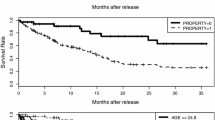Abstract
In this paper an extension of tree-structured methodology to cover censored survival analysis is discussed. Tree-based methods (also called recursive partitioning) provide a useful alternative to the classical survival data analysis techniques, such as the semi-parametric model of Cox, whenever the main purpose is defining groups of individuals, either with complete or censored life history, having different survival probability, based on the values of selected covariates. The essential feature of recursive partitioning is the construction of a decision rule in the form of a binary tree. Trees generally require fewer assumptions than classical methods and handle non standard and non linear data structures efficiently. Tree-growing methods make the processes of covariate selection and grouping of categories in event history models explicit. An example concerning the analysis of time to marriage of Italian women is presented.
Similar content being viewed by others
References
Ahn, H., 1996. 'Log-normal regression modeling through recursive partitioning', Computational Statistics & Data Analysis 21: 381-398.
Ahn, H. and Loh, W.Y., 1994. 'Tree-structured proportional hazards regression modelingt', Biometrics 50: 471-485.
Bacchetti, P. and Segal, M.R., 1995. 'Survival trees with time-dependent covariates: Application to estimating changes in the incubation period of AIDS', Lifetime Data Analysis 1: 35-47.
Blossfeld, H.P. and De Rose, A., 1992. 'Educational expansion and changes in entry into marriage and motherhood: the experience of Italian women', Genus 3-4: 73-89.
Breiman, L., Friedman, J.H., Olshen, R.A. and Stone, C.J., 1984. Classification and Regression Trees, Wadsworth International, Belmont, CA.
Castiglioni, M. and Dalla Zuanna, G., 1994. 'Innovation and tradition: reproductive and marital behaviour in Italy in the 1970s and 1980s', European Journal of Population 10(2): 107-141.
Ciampi, A., Hogg, S.A., McKinney, S. and Thiffault, J., 1988. 'RECPAM: a computer program for recursive partitioning and amalgamation for censored survival data and other situations frequently occurring in biostatistics. I. Methods and program features', Computer Methods and Programs in Biomedicine 26: 239-25
Ciampi, A., Thiffault, J. and Sagman, U., 1989. 'RECPAM: a computer program for recursive partitioning and amalgamation for censored survival data and other situations frequently occurring in biostatistics. II. Applications to data on small cell carcinoma of the lung (SCCL)', Computer Methods and Programs in Biomedicine 30: 283-296.
Ciampi, A. and Thiffault, J., 1989. 'Pruning trees for censored survival data: The RECPAM approach', Communications in Statistics-Theory and Methods 18(9): 3373-3388.
Ciampi, A., 1991. 'Generalized regression trees', Computational Statistics and Data Analysis 12: 57-78.
Cox, D.R., 1972. 'Regression models and life tables' (with discussion), Journal of the Royal Statistical Society Ser. B, 34: 187-220.
Davis, R.B. and Anderson, J.R., 1989. 'Exponential survival trees', Statistics inMedicine 8: 947-961.
Gordon, L. and Olshen, R.A., 1985. 'Tree structured survival analysis', Cancer Treatment Reports 69(10): 1065-1069.
Huang, X., Chen, S. and Soong, S-J., 1995. 'Piecewise proportional hazards survival trees with time-dependent covariates, computationally intensive statistical methods: Proceedings of 26th symposium on the interface', Research Triangle Park, North Carolina, 242-246.
Kalbfleisch, J.D. and Prentice, R.L., 1980. The Statistical Analysis of Failure Time Data. Wiley.
Leblanc, M. and Crowley, J., 1992. 'Relative risk trees for censored survival data', Biometrics 48: 411-425.
Loh, W.Y., 1991. 'Survival modeling through recursive stratification', Computational Statistics & Data Analysis 12: 295-313.
Pallara, A., 1992. 'Binary decision trees approach to classification: A review of CART and other methods with some applications to real data', Statistica Applicata 4(3): 255-285.
Piette, J.D., Intrator, O., Zierler, S., Mor, V. and Stein, M.D., 1992. 'An exploratory analysis of survival with AIDS using a non-parametric tree-structured approach', Epidemiology 3: 310-318.
Pinnelli, A. and De Rose, A., 1995. 'Recent changes in the process of family formation in Italy', in H.P. Blossfeld (ed), The Family Formation in Modern Societies and the New Role of Women. Westview Press, 174-190.
Segal, M.R., 1988. 'Regression trees for censored data', Biometrics 44: 35-47.
Sonquist, J.A., Baker, E.L. and Morgan, J.N., 1973. Searching for Structure (rev. ed.). Ann Arbor: Institute for Social Research, University of Michigan.
Author information
Authors and Affiliations
Rights and permissions
About this article
Cite this article
De Rose, A., Pallara, A. Survival Trees: An Alternative Non-Parametric Multivariate Technique for Life History Analysis. European Journal of Population 13, 223–241 (1997). https://doi.org/10.1023/A:1005844818027
Issue Date:
DOI: https://doi.org/10.1023/A:1005844818027




